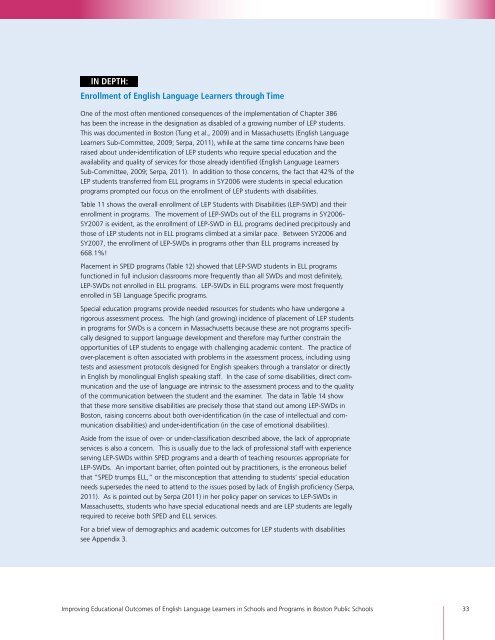Full Report - Center for Collaborative Education
Full Report - Center for Collaborative Education
Full Report - Center for Collaborative Education
Create successful ePaper yourself
Turn your PDF publications into a flip-book with our unique Google optimized e-Paper software.
IN DEPTH:<br />
Enrollment of English Language Learners through Time<br />
One of the most often mentioned consequences of the implementation of Chapter 386<br />
has been the increase in the designation as disabled of a growing number of LEP students.<br />
This was documented in Boston (Tung et al., 2009) and in Massachusetts (English Language<br />
Learners Sub-Committee, 2009; Serpa, 2011), while at the same time concerns have been<br />
raised about under-identification of LEP students who require special education and the<br />
availability and quality of services <strong>for</strong> those already identified (English Language Learners<br />
Sub-Committee, 2009; Serpa, 2011). In addition to those concerns, the fact that 42% of the<br />
LEP students transferred from ELL programs in SY2006 were students in special education<br />
programs prompted our focus on the enrollment of LEP students with disabilities.<br />
Table 11 shows the overall enrollment of LEP Students with Disabilities (LEP-SWD) and their<br />
enrollment in programs. The movement of LEP-SWDs out of the ELL programs in SY2006-<br />
SY2007 is evident, as the enrollment of LEP-SWD in ELL programs declined precipitously and<br />
those of LEP students not in ELL programs climbed at a similar pace. Between SY2006 and<br />
SY2007, the enrollment of LEP-SWDs in programs other than ELL programs increased by<br />
668.1%!<br />
Placement in SPED programs (Table 12) showed that LEP-SWD students in ELL programs<br />
functioned in full inclusion classrooms more frequently than all SWDs and most definitely,<br />
LEP-SWDs not enrolled in ELL programs. LEP-SWDs in ELL programs were most frequently<br />
enrolled in SEI Language Specific programs.<br />
Special education programs provide needed resources <strong>for</strong> students who have undergone a<br />
rigorous assessment process. The high (and growing) incidence of placement of LEP students<br />
in programs <strong>for</strong> SWDs is a concern in Massachusetts because these are not programs specifically<br />
designed to support language development and there<strong>for</strong>e may further constrain the<br />
opportunities of LEP students to engage with challenging academic content. The practice of<br />
over-placement is often associated with problems in the assessment process, including using<br />
tests and assessment protocols designed <strong>for</strong> English speakers through a translator or directly<br />
in English by monolingual English speaking staff. In the case of some disabilities, direct communication<br />
and the use of language are intrinsic to the assessment process and to the quality<br />
of the communication between the student and the examiner. The data in Table 14 show<br />
that these more sensitive disabilities are precisely those that stand out among LEP-SWDs in<br />
Boston, raising concerns about both over-identification (in the case of intellectual and communication<br />
disabilities) and under-identification (in the case of emotional disabilities).<br />
Aside from the issue of over- or under-classification described above, the lack of appropriate<br />
services is also a concern. This is usually due to the lack of professional staff with experience<br />
serving LEP-SWDs within SPED programs and a dearth of teaching resources appropriate <strong>for</strong><br />
LEP-SWDs. An important barrier, often pointed out by practitioners, is the erroneous belief<br />
that “SPED trumps ELL,” or the misconception that attending to students’ special education<br />
needs supersedes the need to attend to the issues posed by lack of English proficiency (Serpa,<br />
2011). As is pointed out by Serpa (2011) in her policy paper on services to LEP-SWDs in<br />
Massachusetts, students who have special educational needs and are LEP students are legally<br />
required to receive both SPED and ELL services.<br />
For a brief view of demographics and academic outcomes <strong>for</strong> LEP students with disabilities<br />
see Appendix 3.<br />
Improving <strong>Education</strong>al Outcomes of English Language Learners in Schools and Programs in Boston Public Schools 33


